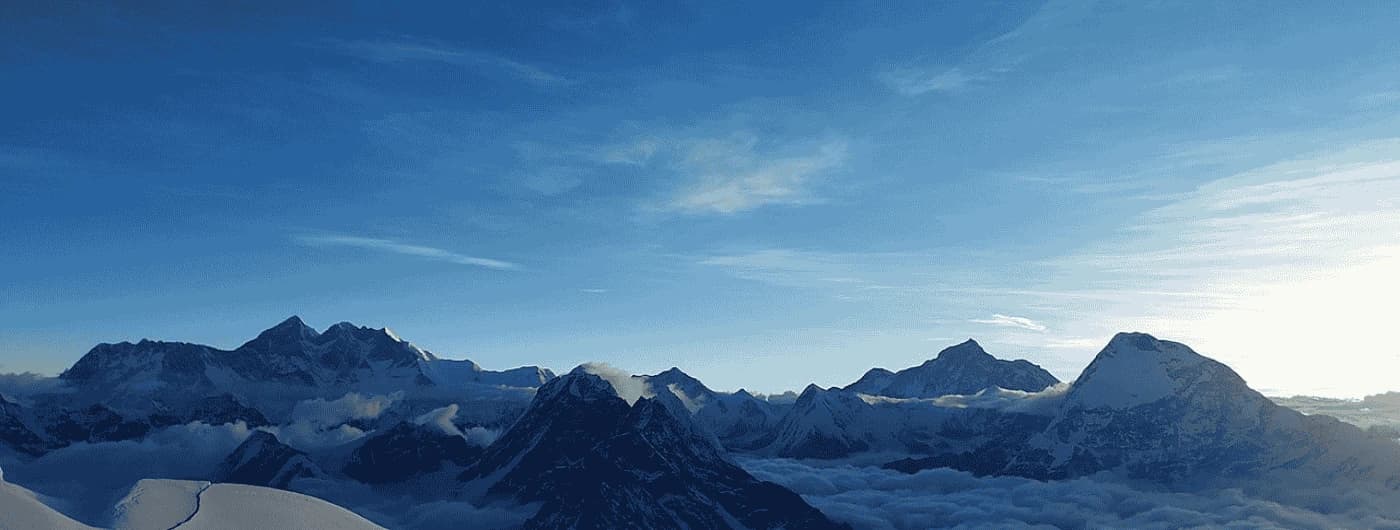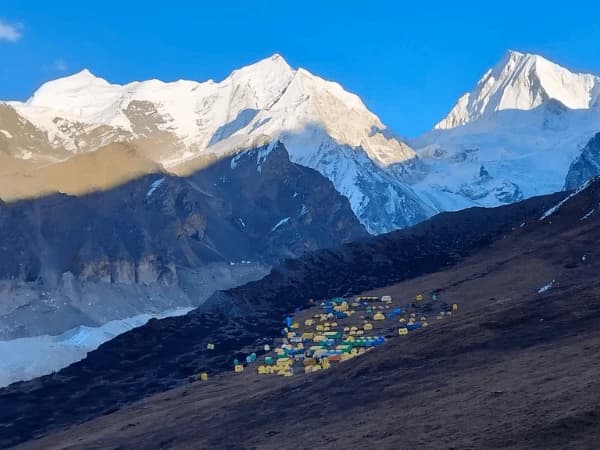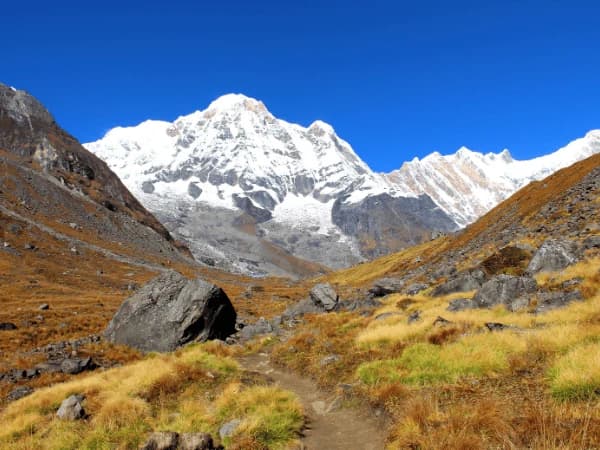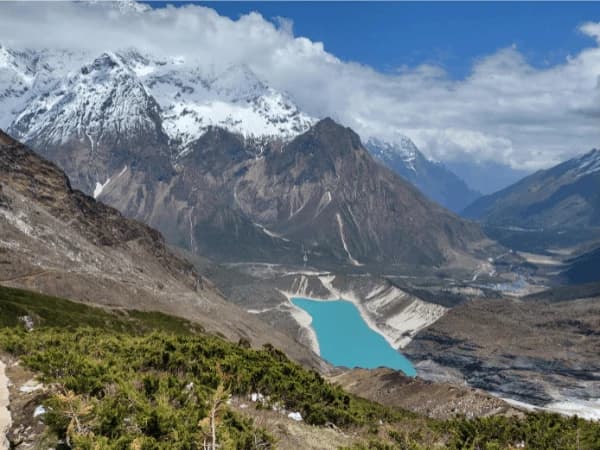Embark on the ultimate Himalayan challenge with Mera Peak—Nepal’s highest trekking peak at 6,476 meters. This comprehensive guide covers everything you need to know about Mera Peak climbing, from breathtaking summit views and expert Sherpa guidance to cost breakdowns, route itineraries, difficulty levels, and preparation tips. Whether you're an aspiring mountaineer or a seasoned trekker looking for your next high-altitude adventure, discover why Mera Peak is the perfect blend of thrill, achievement, and natural beauty, backed by the trusted expertise of Overland Trek Nepal.
The Highest Peak Climbing in Nepal, Mera Peak Summit 2025
The Allure of the Highest Trekking Peak in Nepal
When it comes to peak climbing in Nepal, few names spark as much excitement as Mera Peak. Towering at 6,476 meters, Mera Peak holds the title of the Highest Peak Climbing in Nepal, making it a bucket-list adventure for trekkers and mountaineers worldwide. Whether you're a high-altitude enthusiast or seeking your first Himalayan summit, Mera offers the perfect balance of physical challenge, cultural immersion, and unmatched alpine scenery.
What Makes Mera Peak the Highest Climbing Peak in Nepal?
Mera Peak, located in Nepal's Solu Khumbu region, stands tall amidst the iconic giants of the Himalayas. Its summit rewards climbers with a 360-degree panorama featuring five of the world's tallest mountains: Everest (8,848 m), Lhotse (8,516 m), Makalu (8,481 m), Cho Oyu (8,188 m), and Kanchenjunga (8,586 m).

Unlike technical peaks that demand ropes, ice axes, and crampons from the get-go, Mera Peak is a non-technical climb best suited for trekkers with good fitness and basic snow skills. The high altitude, however, makes it a serious endeavor. That’s what earns Mera its title as the highest trekking peak—less about extreme mountaineering and more about an achievable summit goal above 6,000 meters.
Why Climb Mera Peak? Top Reasons to Take on Nepal’s Highest Trekking Peak
- Stunning Summit Views: The view from the top of Mera is often called the best in Nepal.
- High Altitude Achievement: At 6,476 meters, it’s a major personal milestone to summit the highest trekking peak of Nepal.
- Less Crowded Trail: Compared to Everest or Annapurna regions, the Mera trail remains peaceful and pristine.
- Ideal for Aspiring Mountaineers: A perfect introduction to high-altitude climbing.
- Cultural Immersion: Pass through Sherpa villages, monasteries, and remote yak pastures.
Mera Peak Climbing Itinerary: Day-by-Day Breakdown
Below is a standard 15-day Mera Peak itinerary through the Zatrwa La Pass route. Some itineraries extend to 18–21 days, including additional acclimatization or a longer route via Panch Pokhari. Otherwise, you can also follow our Mera Peak Climbing for the details cost and the package.
Day 1: Fly from Kathmandu to Lukla (2,840 m), Trek to Chutanga (3,020 m) – 3–4 hrs, 7 km
Day 2: Trek to Thuli Kharka via Zatrwa La (4,600 m) – 6–7 hrs, 10 km
Day 3: Trek to Kothe (3,600 m) – 6 hrs, 11 km
Day 4: Trek to Thangnak (4,350 m) – 5 hrs, 8 km
Day 5: Acclimatization Day at Thangnak; Hike to Sabai Tso or Glacier walk
Day 6: Trek to Khare (5,045 m) – 4 hrs, 6 km
Day 7: Rest and Training Day at Khare – Ice climbing and safety briefings
Day 8: Trek to Mera High Camp (5,800 m) – 6 hrs, 6 km
Day 9: Summit Mera Peak (6,476 m) and return to Khare – 10–12 hrs, 15 km
Day 10-13: Retrace to Lukla over 3–4 days
Day 14: Fly from Lukla to Kathmandu
Day 15: Contingency or sightseeing day
Mera Peak Climbing Difficulty: Is It for You?
While Mera Peak is graded as Alpine PD (Peu Difficile), meaning not very difficult, the altitude presents a real challenge. No vertical climbing is needed, but trekkers must walk on glaciers using crampons and ropes. Cold weather, thin air, and long summit day (up to 12 hours) demand solid fitness.
Best for:
- Trekking veterans looking to move into peak climbing
- Fit beginners with high-altitude trekking experience
- Climbers preparing for more technical 7000–8000m peaks or even Mount Everest Expedition.
Best Time to Climb Mera Peak
The two best windows for climbing Mera Peak are:
- Spring (March to May): Stable weather, blooming rhododendrons, and pre-monsoon clarity.
- Autumn (September to November): Crisp skies, excellent visibility, and post-monsoon freshness.
- Avoid monsoon (June–August) and winter (Dec–Feb) unless you're an experienced alpine climber.
Mera Peak Climbing Cost Breakdown (2025 Update)
Climbing Mera Peak, the highest trekking peak in Nepal, is a once-in-a-lifetime adventure, and understanding the cost helps you plan with clarity. In 2025, the total cost for a guided Mera Peak expedition typically ranges between USD 2,800 to 3,200. This price depends on factors like group size, itinerary length, services offered, and the trekking agency’s expertise. While some agencies may offer lower prices, it's important to ensure that the level of safety, logistics, and guide experience aligns with your expectations.
At Overland Trek Nepal, we believe that value goes beyond the price tag. Our packages are competitively priced to offer a fair and transparent cost that reflects the quality of services provided, from experienced Sherpa guides and personalized attention to comfortable accommodation, hearty meals, and essential logistics. Our goal is not just to get you to the summit, but to make your journey enriching, safe, and well-supported every step of the way.
We maintain eco-friendly practices, prioritize ethical treatment of porters and staff, and never cut corners when it comes to your safety. Whether you're a solo climber or part of a group, our Mera Peak climbing package delivers excellent value while upholding the standards you deserve. With Mountain Eco Trails, your investment leads to not just a summit photo, but a lifetime memory, responsibly crafted
Permits & Preparation for Mera Peak
To climb Mera Peak, you’ll need:
- Makalu-Barun National Park Entry Permit
- Local Area Permit (Rural Municipality Fee)
- Mera Peak Climbing Permit (NMA)
Preparation Tips:
- Train 6–8 weeks in advance (cardio, strength, altitude training)
- Hire gear in Kathmandu if needed (ice axe, harness, helmet, boots)
- Take altitude seriously—plan for slow ascents and rest days
Hiring a Guide for Mera Peak: Do You Need One?
Hiring a professional guide is not only essential for safety on Mera Peak,it also enriches the entire climbing experience. Given the glacier crossings, unpredictable Himalayan weather, and high-altitude terrain, trekking solo or unguided can be risky and is not recommended. That’s where Overland Trek Nepal steps in with a team of highly experienced Sherpa guides who are intimately familiar with the Mera Peak region.
Our guides are more than just trail leaders; they are seasoned professionals trained in first aid, altitude sickness response, and high-altitude rescue protocols. Their deep-rooted understanding of the landscape ensures that you stay on the safest and most efficient route. In situations where quick decision-making is vital—whether it’s assessing a crevasse or adjusting pace for acclimatization—our guides bring decades of hands-on expertise to the table.
They also act as cultural liaisons, introducing you to the Sherpa way of life, sharing stories, and helping you engage meaningfully with local communities. During summit day, their encouragement and logistical coordination are invaluable. From managing ropes and equipment to navigating through snowfields and supporting your morale, they are with you every step of the way.
Choosing Overland Trek Nepal means choosing peace of mind, professionalism, and a team committed to making your Mera Peak climbing journey successful, safe, and deeply memorable.
Alternative Climbing Peaks in Nepal
Not sure if Mera Peak is right for you? Consider:
- Island Peak (6,189 m): Slightly lower but more technical
- Lobuche East (6,119 m): Technical ridge and mixed climb
- Pisang Peak (6,091 m): Great views over Annapurna
If you’re looking for a non-technical high-altitude climb, Mera remains unmatched.
Success Tips for a Safe Mera Peak Expedition
- Acclimatize well: Stick to the itinerary, don’t skip rest days.
- Hydrate & eat well: Drink plenty of water and eat a nutritious meal to fuel your body for the climb.
- Train ahead: Focus on hiking with a pack and altitude exposure
- Go with professionals: Ascend with our professional climbing Sherpa Guide.
- Pre-trained climbing preparation: Listen to your climbing guide during the pre-trained climbing preparation.
Book Your Mera Peak Climbing Adventure with Confidence
At Overland Trek Nepal, we specialize in high-altitude experiences that prioritize your safety, success, and sustainability. Our experienced Sherpa guides, eco-conscious values, and custom itineraries make us the perfect partner for your Mera Peak ascent.
FAQs:
What is the highest trekking peak in Nepal?
Mera Peak (6,476 m) is the highest trekking peak in Nepal, officially classified by the Nepal Mountaineering Association.
How hard is it to climb Mera Peak?
Mera Peak is considered a non-technical climb but demands high physical fitness and acclimatization due to its extreme altitude.
When is the best time to climb Mera Peak?
Spring (March–May) and Autumn (Sept–Nov) offer the best weather and clear views for a successful summit.
What is the cost to climb Mera Peak?
The cost ranges from USD 2,100–2,700, depending on the service, group size, and route.
Do I need a guide for Mera Peak?
Yes, a guide is mandatory for safety and logistical reasons, especially due to glacier crossings and summit challenges.
Conclusion: Claim the Summit of the Highest Trekking Peak in Nepal
Climbing Mera Peak is not just about reaching the highest Peak climbing in Nepal—it’s about pushing your limits, experiencing Sherpa culture, and seeing the Himalayas from a vantage point very few ever reach. With preparation, guidance, and determination, Mera Peak can be the adventure of a lifetime. Contact our peak climbing expert via email or WhatsApp at +9779851138871 and let us organize your dream trip to the highest trekking peak of Nepal.




